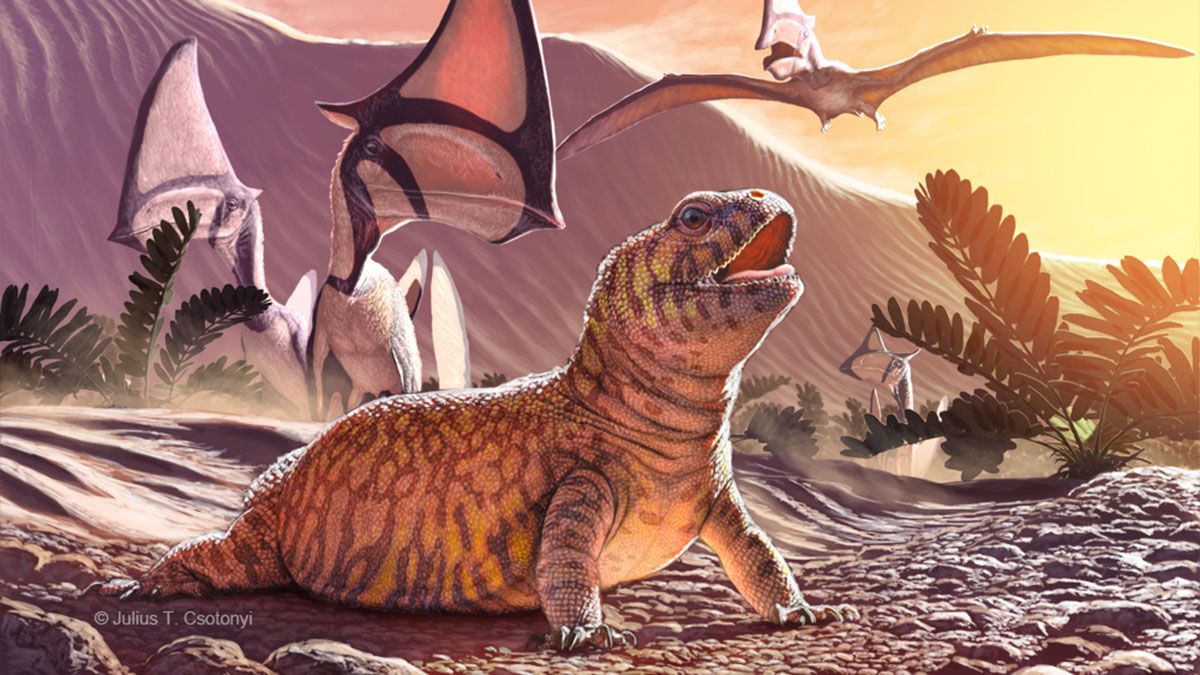 Supplied – Julius Csotonyi
Supplied – Julius CsotonyiWhen a paleontologist at a Brazilian dig site heaved a sandstone at a fellow crewmember as a practical joke, it split apart as it left his hands. He didn’t intent for it to break, nor did he intend to find a fossil in the act. But he did — inside the rock were the remains of a never-before-seen lizard.
The specimen, which has been named Gueragama sulamericana, was described by a team of University of Alberta and Universidade do Contestado (Mafra, Brazil) paleontologists. The discovery challenges old ideas about the history of lizards in South America.
G. sulamericana is special because it’s part of a lizard subgroup which has never been found in the Americas, U of A Evolution and Systematics graduate student Tiago Rodrigues Simões said. Simões was the lead author of the paper, published in Nature Connections in August.
The oddball fossil of was found in a Brazilian bonebed that contained mainly pterosaurs — ancient flying reptiles that have been popularized by the Jurassic Park series. Finding the lizard among pterosaur remains was an accident, Simões said.
The team working on the bonebed contacted Simões, who specializes in ancient South American lizards, after finding the lizard fossil in a rock that was being used in a digsite prank.
“The work on this site has been going on for two years, very important work,” Simões said. “But sometimes important discoveries happen by chance, and it happens all the time.”
The iguanids of the New World, which include iguanas, but many other lizards as well, have always been found with teeth growing from the inner surface of the jawbone — these animals are called pleurodonts. However, the newly discovered species is an acrodont, meaning its teeth grow from the top surface of the jawbone instead. It’s typical to only find one or the other in a region, Simões said.
“This finding indicates that a really long time ago, 18 million years ago, we had one of the members of the Old-world group … in South America,” he said.
The ancient acrodont resembles most closely a genus of herbivorous desert-dwelling lizard that occupies desert regions of Northern Africa and the Middle East.
“Our species is very similar and (also lived) in a desertic environment, but 80 million years ago,” Simões said.
The lizard was likely a dusty colour, which would have camouflaged it in the sandy, rocky environment. It was named in the most spoken pre-Columbian language in Brazil: “Guera” is Tupi–Guarani for “ancient.” “Agama” refers to the family of modern lizard which the precimen closely resembles. “Sulamericana” is Portuguese for “South America.”
The finding has raised questions as to why the acrodont group disappeared from South America. Simões and his colleagues have suggested two possibilities. South American acrodonts may have succumbed to the same conditions that killed off the dinosaurs, while the plurodonts were more resilient. Or, ancient South American pleurodonts may have been better at competing for resources.
To find out whether one of these hypotheses are true, paleontologists will have to gather more data by sampling, Simões said. This means more digging, and more travelling to examine specimens.
If more fossils turn up at the site, Simões may travel to examine them, and perhaps uncover more clues about G. sulamericana — one of the perks (and challenges) of studying ancient remains. For now, the lizard expert is recharging at home after a seven month trip examining specimens in Europe.
To properly study fossils, one has to travel and see them personally in order to see their fine details, Simões said.
“Fossils are really rare and special things,” he said.




